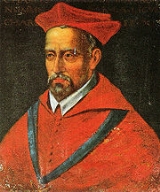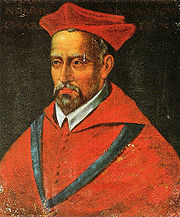
Charles, Cardinal de Bourbon
Encyclopedia

Catholic League (French)
The Catholic League of France, sometimes referred to by contemporary Roman Catholics as the Holy League, a major player in the French Wars of Religion, was formed by Duke Henry of Guise in 1576...
considered him the rightful King of France after the death of Henry III of France
Henry III of France
Henry III was King of France from 1574 to 1589. As Henry of Valois, he was the first elected monarch of the Polish-Lithuanian Commonwealth with the dual titles of King of Poland and Grand Duke of Lithuania from 1573 to 1575.-Childhood:Henry was born at the Royal Château de Fontainebleau,...
in 1589.
Biography
He was born at La Ferté-sous-JouarreLa Ferté-sous-Jouarre
La Ferté-sous-Jouarre is a commune in the Seine-et-Marne département in the Île-de-France region in north-central France.It is located at a crossing point over the River Marne between Meaux and Château-Thierry.-History:...
, in what is now the department of Seine-et-Marne
Seine-et-Marne
Seine-et-Marne is a French department, named after the Seine and Marne rivers, and located in the Île-de-France region.- History:Seine-et-Marne is one of the original 83 departments, created on March 4, 1790 during the French Revolution in application of the law of December 22, 1789...
, the eighth child of Charles IV de Bourbon, duke of Vendôme. His mother was Françoise d'Alençon
Françoise d'Alençon
Françoise d'Alençon was the eldest daughter of René of Alençon and Margaret of Lorraine, and the younger sister and despoiled heiress of Charles IV, Duke of Alençon....
.
Charles made a rapid career in the Roman Catholic hierarchy. He was bishop of Nevers (1540–1545), bishop of Saintes (1545–1550, elevated to cardinal
Cardinal (Catholicism)
A cardinal is a senior ecclesiastical official, usually an ordained bishop, and ecclesiastical prince of the Catholic Church. They are collectively known as the College of Cardinals, which as a body elects a new pope. The duties of the cardinals include attending the meetings of the College and...
in 1548), archbishop of Rouen
Archbishop of Rouen
The Roman Catholic Archdiocese of Rouen is an Archdiocese of the Latin Rite of the Roman Catholic Church in France. As one of the fifteen Archbishops of France, the ecclesiastical province of the archdiocese comprises the majority of Normandy....
(1550–1590), bishop of Nantes (1550–1554), Papal legate
Papal legate
A papal legate – from the Latin, authentic Roman title Legatus – is a personal representative of the pope to foreign nations, or to some part of the Catholic Church. He is empowered on matters of Catholic Faith and for the settlement of ecclesiastical matters....
in Avignon
Avignon
Avignon is a French commune in southeastern France in the départment of the Vaucluse bordered by the left bank of the Rhône river. Of the 94,787 inhabitants of the city on 1 January 2010, 12 000 live in the ancient town centre surrounded by its medieval ramparts.Often referred to as the...
(1565–1590) and bishop of Beauvais (1569–1575). In 1551 he was made Lieutenant-General of Paris
Paris
Paris is the capital and largest city in France, situated on the river Seine, in northern France, at the heart of the Île-de-France region...
and Ile de France
Île-de-France (province)
The province of Île-de-France or Isle de France is an historical province of France, and the one at the centre of power during most of French history...
. On 31 December 1578 he was made the first commander in the Order of the Holy Spirit
Order of the Holy Spirit
The Order of the Holy Spirit, also known as the Order of the Knights of the Holy Spirit, was an Order of Chivalry under the French Monarchy. It should not be confused with the Congregation of the Holy Ghost or with the Order of the Holy Ghost...
.
When the duke of Alençon and Anjou died childless in 1584 while King Henry III of France
Henry III of France
Henry III was King of France from 1574 to 1589. As Henry of Valois, he was the first elected monarch of the Polish-Lithuanian Commonwealth with the dual titles of King of Poland and Grand Duke of Lithuania from 1573 to 1575.-Childhood:Henry was born at the Royal Château de Fontainebleau,...
was also still childless it was clear that the house of Valois would come to an end with the death of the king and the succession to the French throne would then pass to the house of Bourbon-Vendôme who were descended from Louis IX
Louis IX of France
Louis IX , commonly Saint Louis, was King of France from 1226 until his death. He was also styled Louis II, Count of Artois from 1226 to 1237. Born at Poissy, near Paris, he was an eighth-generation descendant of Hugh Capet, and thus a member of the House of Capet, and the son of Louis VIII and...
. However, the senior member of the family, Henry III of Navarre
Henry IV of France
Henry IV , Henri-Quatre, was King of France from 1589 to 1610 and King of Navarre from 1572 to 1610. He was the first monarch of the Bourbon branch of the Capetian dynasty in France....
(son of Charles's late elder brother Antoine
Antoine of Navarre
Antoine de Bourbon, Duke of Vendôme was head of the House of Bourbon from 1537 to 1562, and jure uxoris King of Navarre from 1555 to 1562.-Family:...
), was a Protestant. The Catholic League
Catholic League (French)
The Catholic League of France, sometimes referred to by contemporary Roman Catholics as the Holy League, a major player in the French Wars of Religion, was formed by Duke Henry of Guise in 1576...
, party to the French Wars of Religion
French Wars of Religion
The French Wars of Religion is the name given to a period of civil infighting and military operations, primarily fought between French Catholics and Protestants . The conflict involved the factional disputes between the aristocratic houses of France, such as the House of Bourbon and House of Guise...
, excluded all Protestants from the succession, which made Charles de Bourbon their champion. In the secret Treaty of Joinville
Treaty of Joinville
The Treaty of Joinville was signed in secret in December 31, 1584 by the French Catholic League, led by France's first family of Catholic nobles, the Guises, and Habsburg Spain. In this treaty, Philip II, King of Spain, agreed to finance the Catholic League...
of 31 December 1584 he was anointed by the leaders of the league and a representative of Philip II of Spain
Philip II of Spain
Philip II was King of Spain, Portugal, Naples, Sicily, and, while married to Mary I, King of England and Ireland. He was lord of the Seventeen Provinces from 1556 until 1581, holding various titles for the individual territories such as duke or count....
. Henry III had Charles imprisoned in the castle of Blois
Blois
Blois is the capital of Loir-et-Cher department in central France, situated on the banks of the lower river Loire between Orléans and Tours.-History:...
on 23 December 1588. He was transferred from one castle to another, presumably to prevent escape. On Henry III's death in 1589, the League proclaimed Charles king, while he was still a prisoner and in the castle of Chinon
Chinon
Chinon is a commune in the Indre-et-Loire department in central France well known for Château de Chinon.In the Middle Ages, Chinon developed especially during the reign of Henry II . The castle was rebuilt and extended, becoming one of his favorite residences...
. He was recognized as Charles X by the parliament of Paris on 21 November 1589. His prison was considered too close to Catholic territory, so he was again transferred, this time to Fontenay-le-Comte. The Catholic League issued coins in his name from 2 August 1589 to his death from 15 Mints, including Paris. Charles, however, renounced the royal title and recognized his nephew Henry IV
Henry IV of France
Henry IV , Henri-Quatre, was King of France from 1589 to 1610 and King of Navarre from 1572 to 1610. He was the first monarch of the Bourbon branch of the Capetian dynasty in France....
, whose succession was disputed
Henry IV of France's succession
Henry IV of France's succession to the throne in 1589 was followed by a four-year war to establish his legitimacy. Henry IV inherited the throne after the assassination of Henry III, the last Valois king, who died without children...
by the Catholic League
Catholic League (French)
The Catholic League of France, sometimes referred to by contemporary Roman Catholics as the Holy League, a major player in the French Wars of Religion, was formed by Duke Henry of Guise in 1576...
. He died in the castle of Fontenay-le-Comte
Fontenay-le-Comte
Fontenay-le-Comte is a commune in the Vendée department in the Pays de la Loire region in France. It is a sub-prefecture of the department.-Geography:The Vendée River flows though the town. The town has an area of .-History:...
.
When the Comte d'Artois ascended the French throne in 1824, he definitively demonstrated Charles de Bourbon's lack of legitimacy by styling himself Charles X of France
Charles X of France
Charles X was known for most of his life as the Comte d'Artois before he reigned as King of France and of Navarre from 16 September 1824 until 2 August 1830. A younger brother to Kings Louis XVI and Louis XVIII, he supported the latter in exile and eventually succeeded him...
.

